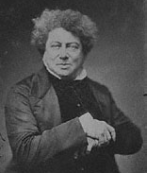*Alexandre Dumas was born on this date in July 24, 1802. He was a Black European who was one of the more prolific writers during the 19th century theater.
Born in Villers-Cotterêts near Paris. His grandfather was the Marquis Antoine-Alexandre Davy de la Pailleterie and his grandmother was Marie-Céssette Dumas, a Black slave from Jérémie, Saint-Domingue (Haiti). Young Alexandre grew up in Villers-Cotterêts. Dumas's father was a general in Napoleon's army, who had fallen out of favor. After his death in 1806 the family lived in poverty. Dumas worked as a clerk and went in 1823 to Paris to find work.
Because of his stylish handwriting he got work with the Duc d'Orléans, later King Louis Philippe. He also began working in theater and as a magazine publisher. By age twenty-five, he had his first success as a playwright with "Henri III et Sa Cour" (1829), produced by the Comedie Francaise. It gained success and Dumas went on to write additional plays. "La Tour de Nesle" (1832, "The Tower of Nesle") is considered the greatest masterpiece of French melodrama. He wrote constantly, producing a steady stream of plays, novels, and short stories.
Dumas has written many interesting observations about the world during his life. Much can be found in his piece “Mes Mémoires.” Dumas also wrote several children's stories, and a culinary dictionary. He also did not shy away from collaborating with other authors or rewriting older stories. Writing brought Dumas enormous fortune, but he spent money faster than he made it. He produced some 250 books with his 73 assistants, especially with the history teacher Auguste Maquet, whom worked independently. His most successful novels contained vivid adventures with action, and bigger-than-life characters. He took great liberty with the truth to achieve a good story.
His son, Alexandre Dumas fils, wrote several important novels including La Dame aux Camélias, the basis of Verdi's opera La Traviata. Dumas’ life as a writer was filled years of traveling, and carousing. Some of his writings were, The Count of Monte-Cristo, The Man in the Iron Mask, and The Three Musketeers. In a shorter piece, “Georges” (1843, George), Dumas examined the question of race and colonialism. The main character, a half-French mulatto, leaves Mauritius to be educated in France, and returns to revenge for the affronts he had suffered as a boy. Alexandre Dumas died in Puys, near Dieppe, on December 5, 1870.
References: The Literature Network
Wikimedia Foundation
204 37th Avenue North Suite330
St. Petersburg, FL. 33704


